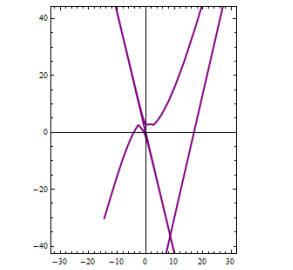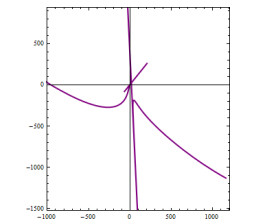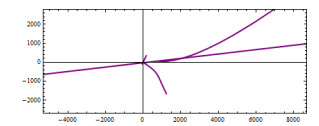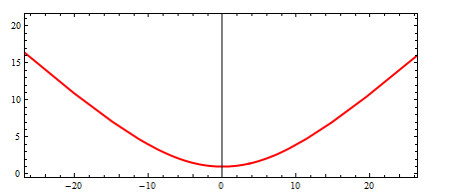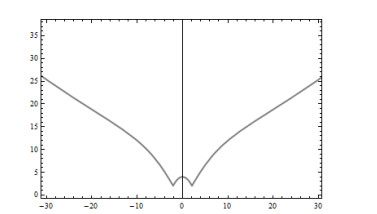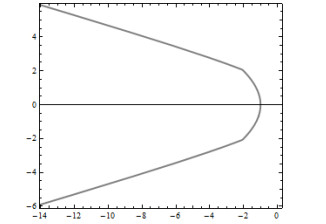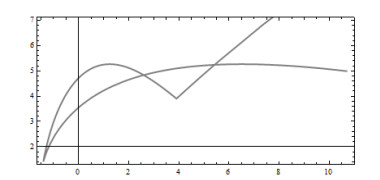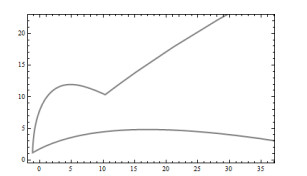1.
Introduction
Einstein presented work on general relativity as a theory of space, time and gravitation in pseudo-Euclidean space in 1915. Even so, this topic has stayed immobile for much of its rich history because its conception requires advanced mathematics awareness. Since the end of the twentieth century, pseudo-Euclidean geometry has been an energetic area of mathematical research, and it has been applied to a variety of subjects relating to geometry and relativity.
A lot of vital outcomes in the theory of curves in R3 were started by Monge, and Darboux pioneered the moving frame concept. Subsequently, Serret-Frenet equations had a vital role in these topics. It is well known that Einstein's concept paved the way to learning about other types of geometries. One of the most important of these geometries is Minkowski geometry.
The concept of a singularity is a vital point in nonlinear studies. Specially, it has been widely used in categorizations of singularities correlating with some topics in different spaces (see [1,2]).
In the early 18th century, pedal curves were presented by Collin Maclaurin as the position of the foot of the orthogonal from the certain point to the tangent to a specific curve. In [3], T. Nishimura gave the meaning and the categorizations of the singularities of pedal curves of regular curves in the unit sphere. In [4], Božek and Foltán discussed the relations among singular points of the pedal curves and inflection points of regular curves in the Euclidean plane. If the curve is not regular at any point, we are not able to define the pedal curve at this point as in the traditional method. Fukunaga and Takahashi have studied frontals (sometimes known as fronts) in the Euclidean plane and also investigated Legendrian curves in the unit tangent bundle of R2 (see[5,6,7]). Legendrian curves are also known as Legendrian immersions. In [8,9], authors studied some geometric properties of the frontal. Also, Li and Pei have achieved some work related to pedal curves of fronts in the sphere. They recognized the pedal curves of fronts and introduced the classification of singularities of the pedal curves of fronts in the sphere. Moreover, some of the latest connected studies can be seen in [10,11,12,13,14,15,16]. The main variation between a regular curve and a frontal is that the frontal might have singular points. A key instrument for investigation of the frontal is said to be a moving frame realized in the unit tangent bundle. With the use of the moving frame, one can express a new definition of the pedal curve of the frontal. When the curve is a regular one, this new idea of the pedal curve is compatible with the traditional one.
This work aims to present the concept of the anti-pedal of a curve in which its singularities also coincide with the inflection points of the main curve. Further, we demonstrate that the primitive is the same as the anti-pedal of the inversion image of the given curve. There is one more idea, which is introduced as the notion of primitivoids of a curve in the Minkowski plane, which are relatives of the primitive. There are two methods to determine primitivoids. One is known as a parallel primitivoid and the other is a slant primitivoid. At last, we treat these concepts for frontal curves and establish the relationships. The main results are in sections 3–6. During this work, we assume that ζ is a timelike curve, and all maps are class C∞.
2.
Geometric meanings and basis concepts
In this part, we present some geometric properties of the Minkowski plane. More details can be seen in [10,11,12,13]. The Minkowski plane R21 is the Euclidean plane R2 with the metric ⟨x,y⟩=−x1y1+x2y2, where x=(x1,x2), and y=(y1,y2). A non-zero vector x in R21 is spacelike, lightlike or timelike if ⟨x,x⟩>0, ⟨x,x⟩=0 or ⟨x,x⟩<0, respectively. The norm of a vector x=(x1,x2)∈R21 is denoted by ‖x‖=√|⟨x,x⟩|. We express by x⊥ the vector denoted by x⊥=(x2,x1). It is easy to see that x⊥ is orthogonal to x (i.e.,⟨x,x⊥⟩=0), and ‖x‖=‖x⊥‖. We find x⊥=±x if and only if x is lightlike, and x⊥ is timelike (respectively, spacelike) if and only if x is spacelike (respectively, timelike).
Furthermore, we indicate three types of pseudo-circle in R21, which have the center v∈R21 and radius r≥0.
Suppose ζ:I→R21 is a smooth curve in R21. The curve ζ is said to be spacelike, timelike or lightlike if ζ′(t)=dζdt(t) is spacelike, timelike or lightlike for any t∈R, respectively. Also, ζ is non-lightlike if ζ is timelike or spacelike.
Let the curve ζ:I⟶R21 be a non-lightlike. Here, s is the arc-length parameter. Then, this leads to ‖ζ′(s)‖=1 for all s∈I, where ζ′(s)=(dζ/ds)(s). We refer by e1(s) and e2(s) to the unit tangent and normal vectors to ζ(s), respectively, such that {e1(s),e2(s)} is oriented anti-clockwise. In fact, e1(s)=ζ′(s), and e2(s)=(−1)w+1ζ′(s)⊥, such that w=1 if ζ is timelike, and w=2 if ζ is spacelike.Thus, we find the Serret-Frenet equations:
where κ(s) is the curvature of ζ. Therefore,
Even if ζ is not parameterized by the arc-length, and t denotes the parameter, then {e1(t),e2(t)} are expressed as
This leads to
and the curvature function is denoted by κ(t)=⟨¨ζ(t),˙ζ(t)⊥⟩/‖˙ζ(t)‖3 (see[17,18]).
We call ζ:I→R21 a spacelike frontal in R21 if there exists a smooth map ν:I→H10(ζ) where the pair (ζ,ν):I→R21×H10(ζ) is a spacelike Legendrian curve, that is, (ζ(t),ν(t))∗θ=0 for each t∈I, where θ is a canonical contact structure on T1R21=R21×H10(ζ). Note that the second condition is tantamount to ˙ζ(t)⋅ν(t)=0 for each t∈I. Furthermore, if (ζ,ν):I→R21×H10(ζ) is a spacelike Legendrian immersion, that is, (˙ζ(t),˙ν(t))≠(0,0) for each t∈I, we regard ζ:I→R21 as a spacelike front (or a spacelike wave front) in R21. Otherwise, (ζ,ν) is said to be a timelike Legendrian curve; that is, (ζ(t),ν(t))∗θ=0 for each t∈I, then ζ is called a timelike frontal. Hence, (ζ,ν) is said to be a non-lightlike Legendrian curve, if (ζ,ν) is a spacelike Legendrian curve or a timelike Legendrian curve. Here, we only consider non-lightlike Legendrian curves in R21.
Let (ζ,ν):I→R21×S11(or H10) be a non-lightlike Legendrian curve. Then, in the light of orthonormal frame {ν(t),μ(t)} along ζ(t), there are Frenet type formulae:
Further, we find β(t) where ˙ζ(t)=β(t)μ(t) for any t∈I. The pair (ℓ,β) is said to be the curvature of (ζ,ν). (See for more details, [5,19,20]).
3.
Pedals, anti-pedals and primitives
Here, we present the notion of anti-pedals, which plays a vital role in this work. More details can be seen in [8,9,10,11,12,13,18,21,22]. The pedal curve of ζ is given by Peζ(s)=−⟨ζ(s),e2(s)⟩e2(s), where e2(s)=Je1(s) is the unit normal, and we refer to the Jacobian matrix by J. After some manipulations, we get
The singular point of the pedal of ζ is the point s0 where ζ(s0)=0 or κ(s0)=0 (i.e., s0 is the inflection point of ζ). If we suppose that ζ does not pass through the origin, then by definition, Peζ(s) is the point on the tangent line through ζ(s), which is denoted by the projection image of ζ(s) of the normal direction. Therefore, Peζ(s)−ζ(s) produces the tangent line at ζ(s).
Let ζ:I⟶R21∖{0} be a unit speed plane curve, and then we give a family of functions H:I×(R21∖{0})⟶R21 by H(s,u)=⟨u−ζ(s),ζ(s)⟩. For any fixed s∈I, hs(u)=H(s,u)=0 is the line through ζ(s) and orthogonal to the position vector ζ(s). The envelope of the family of the lines {h−1s(0)}s∈I is the primitive of ζ(s). Since ∂H/∂s(s,u)=⟨u−2ζ(s),e1(s)⟩, {e1(s),e2(s)} is an orthonormal basis of R21, and therefore, we can write u=λe1(s)+μe2(s). From
we have
The primitive Prζ:I⟶R21∖{0} of ζ is
Assume that Peζ(s) and Prζ(s) are regular curves. Therefore, we have PrPeζ(s)=PePrζ(s)=ζ(s).
Even though the concept of a pedal is interpreted in R21, we choose the origin. Therefore, the pedal is stated as the envelope of a family of pseudo-circles:
Let G:I×R21⟶R21 be a function given by
Arranging this equation, we obtain
If we fix s0∈I, then G(s0,u)=0 is a pseudo-circle which has the center 12ζ(s0) and passes through the origin.
For a fixed s∈I, gs(u)=G(s,u)=0 is a pseudo-circle through the origin. Then, the inversion image of it is a line. If we recognize the inversion Ψ:R21∖{0}⟶R21∖{0} at the origin with respect to the unit circle by Ψ(u)=u‖u‖2, we get Ψ(g−1s(0))={u∣⟨u,ζ(s)⟩=1}. Therefore, we define a family of functions F:I×R21∖{0}⟶R by F(s,u)=⟨u,ζ(s)⟩−1. Then ∂F/∂s(s,u)=⟨u,e1(s)⟩, and we get F(s,u)=∂F/∂s(s,u)=0 if and only if
Thereafter, a mapping APeζ:I×R21∖{0}⟶R which is expressed as
is known as an anti-pedal curve of ζ. Therefore, we find Ψ∘APeζ=Peζ, and Ψ∘Peζ=APeζ.
Proposition 3.1. Assume that ζ:I⟶R21∖{0} is a unit speed plane curve. Therefore, we find
Proof. According to the properties of {h−1s(0)}s∈I, since H(s,u)=⟨u,ζ(s)⟩−‖ζ(s)‖2, H(s,u)=0 if and only if ⟨u,Ψ∘ζ(s)⟩=1. Subsequently, the envelope of the family of lines {h−1s(0)}s∈I is equal to the anti-pedal of Ψ∘ζ. This leads to Prζ(s)=APeΨ∘ζ(s). Since Ψ∘Ψ=1R21∖{0}, we obtain
which leads to the required result.
Since Ψ is a diffeomorphism, the pedal Peζ and the anti-pedal APeζ=Ψ∘Peζ(s) have the same singularities, which correspond to the inflection points of ζ. Thus, the singularities of the primitive Prζ(s)=APeΨ∘ζ correspond to the inflections of the inversion curve Ψ∘ζ. Now, we compute the curvature of Ψ∘ζ.
Proposition 3.2. Let ζ:I⟶R21∖{0} be a unit speed curve. Then, the curvature of Ψ∘ζ at s∈I is κΨ∘ζ(s)=−κ(s)‖ζ(s)‖2+2⟨ζ(s),e2(s)⟩.
Proof. Since α(s)=Ψ∘ζ(s)=ζ(s)‖ζ(s)‖2,
Assume σ is the arc-length parameter of α(s). Therefore, dσ/ds=1/‖ζ‖2.
Moreover,
and from relations
we get
By the Frenet formula and from Eqs (3.4) and (3.5), we get
and then we have
It follows that
and
which completes the proof.
Therefore, we have the result:
Corollary 3.1. Let ζ:I⟶R21∖{0} be a unit speed curve, and from Eq (3.6), we have
Then, κ′(s)=0 if and only if κ′Ψ∘ζ(s)=0.
We say that the point s0∈I with κ′(s0)=0 is a vertex of ζ. Therefore, the previous result confirms that the vertices of ζ and Ψ∘ζ are identical. Also, the point s0∈I is an inflection point of ζ if and only if κ(s0)=0.
4.
Parallel primitivoids in Minkowski plane
Now, we investigate a family of functions H:(I×R21∖{0})⟶R given by H(s,u)=⟨u−rζ(s),ζ(s)⟩. More details can be seen in [8,9,10,11,12,13,18,21,22]. Therefore, {h−1s(0)}s∈I is a family of lines which are orthogonal to ζ(s) through rζ(s), where hs(u)=H(s,u). Therefore, by definition, the envelope of these lines is the r-parallel primitivoid of ζ. Since {e1(s),e2(s)} is an orthonormal frame along ζ, then there exist λ,μ∈R such that u−rζ(s)=λe1(s)+μe2(s). Thus, we obtain
Then,
since ∂H/∂s(s,u)=0 if and only if λ=−r⟨ζ(s),e1(s)⟩, and F(s,u)=0 if and only if ⟨λe1(s)+μe2(s),ζ(s)⟩=0, which means that
or, in the another form,
Then,
If ⟨e2(s),ζ(s)⟩≠0, then we get F(s,u)=∂H/∂s(s,u)=0 if and only if
From Eq (3.5), the last equation becomes
Therefore, the parametrization of the r-parallel primitivoid is obtained as follows
and is given by r-Prζ(s).
Since
we obtain the following result:
Theorem 4.1. Assume ⟨e2(s),ζ(s)⟩≠0. Then, r-Prζ(s)=rPrζ(s)=Prrζ(s).
Proof. For rPrζ(s), the unit tangent vector is re1(s)/‖re1(s)‖2=e1(s), and therefore e2(s) is the unit normal vector of rPrζ(s). Hence, we get
which is our required result.
5.
Slant primitivoids
The definition of primitivoids of Euclidean plane curves was introduced by Izumiya and Takeuchi (2019) (see [21]). More related studies can be seen in [10,11,12,13,14,15,16,22]. Analogous to their notions in Euclidean plane, we can give the ψ-slant primitivoid as the envelope of the family of lines with the constant angle ψ to the position vector of the curve. Therefore, we introduce the following accurate definition:
Consider ζ:I⟶R21∖{0} to be a unit speed curve, and we find ζ(s)=−⟨ζ(s),e1(s)⟩e1(s)+⟨ζ(s),e2(s)⟩e2(s). Therefore, the π/2 couterclockwise-rotated vector is Jζ(s)=−⟨ζ(s),e2(s)⟩e1(s)+⟨ζ(s),e1(s)⟩e2(s). For ψ∈R, we present the definition
Now, we evaluate a function F:(I×R21∖{0})⟶R given by F(s,u)=⟨u−ζ(s),N[ψ](s)⟩. For s∈I, fs(u)=F(s,u)=0 is an equation of the line through ζ(s) orthogonal to N[ψ](s), and the angle between the line and the position vector ζ(s) is ψ+π/2. The envelope of the family of lines {f−1s(0)}s∈I is called a ψ-slant primitivoid of ζ. We consider a parametrization of the ψ-slant primitivoid of ζ. The ψ-slant primitivoid of ζ is given by Pr[ψ]ζ(s).
Theorem 5.1. Let ζ:I⟶R21∖{0} be a unit speed curve such that ⟨ζ(s),e2(s)⟩≠0. Then, we obtain
Proof. Since N[ψ](s)=coshψζ(s)+sinhψJζ(s), we have N[ψ]′(s)=coshψe1(s)+sinhψJe1(s)=coshψe1(s)+sinhψe2(s). Then, F(s,u)=0 if and only if there exits λ∈R such that u−ζ(s)=λ(coshψJζ(s)+sinhψζ(s)). From relations ζ=−⟨ζ,e1⟩e1+⟨ζ,e2⟩e2, and Jζ=−⟨ζ,e2⟩e1+⟨ζ,e1⟩e2, we note that ⟨Jζ,e2⟩=⟨ζ,Jte2⟩=−⟨ζ,Je2⟩=⟨ζ,e1⟩ and ⟨Jζ,e1⟩=⟨ζ,Jte1⟩=⟨ζ,Je1⟩=⟨ζ,e2⟩. Also, we obtain ⟨ζ,ζ⟩=−⟨Jζ,Jζ⟩. With the condition F(s,u)=0, we get
Thereby, F(s,u)=∂F(s,u)/∂s=0 if and only if
and then
From Eq (3.5), and the relation Jζ(s)=−⟨ζ(s),e2(s)⟩e1(s)+⟨ζ(s),e1(s)⟩e2(s), we find
and then
Where Prζ(s)=2ζ(s)−‖ζ(s)‖2⟨ζ(s),e2(s)⟩e2(s), Jζ(s) is a unit speed curve such that the tangent vector is Je1(s)=e2(s), and the normal vector is Je2(s)=JJe1(s)=−e1(s), which yields that
Thus, we arrive at
which is our desired conclusion.
Corollary 5.1. Consider a unit speed curve is given by ζ:I⟶R21∖{0}, such that ⟨ζ(s),e2(s)⟩≠0. Therefore, we obtain
Proof. Since
from Theorem 5.1, we find
and the proof is completed.
Theorem 5.2. With the same notations as above, we conclude
Proof. According to Theorem 5.1 and Corollary 5.1, we get
where I is the identity matrix, and then we find
where R(ψ)=coshψI+sinhψJ. This leads to our required result.
Hereafter, we investigate the relations between primitivoids and pedals. For λ∈R∖{0}, we give λζ(s). Since (λζ)′(s)=λe1(s), ‖λe1(s)‖=−|λ|, so e1λζ(s)=e1(s) for λ<0, and e2λζ(s)=Je1(s)=e2(s). Also, we have e1λζ(s)=−e1(s) for λ>0 and e2λζ(s)=J(−e1(s))=−e2(s). Therefore, we find Peλζ(s)=λPeζ(s). Then, we arrive at the following result:
Proposition 5.1. Assume that Peζ and Pr[ψ]ζ are regular curves. Therefore,
Proof. By the aforementioned information and Theorem 5.2, we obtain
and
which is the required result.
Now, we investigate the relations of primitivoids with anti-pedals and parallel primitivoids.
Proposition 5.2. Consider a unit speed curve ζ:I⟶R21∖{0} such that ⟨e2(s),ζ(s)⟩≠0. Therefore,
Proof. According to Proposition 3.1 and Theorem 5.2, we get
By Theorem 4.1, we obtain
which leads to the desired result.
6.
Pedals and primitivoids of frontals in Minkowski plane
In this part, we propagate the concept of primitivoids and pedals of certain singular curves. The pedal of non-lightlike frontal ζ is denoted by Peζ(t)=⟨ζ(t),ν(t)⟩ν(t) (for more details, see [18,22,23]). Furthermore, the anti-pedal of ζ is construed to be
As we noted for a regular curve ζ in §3, the anti-pedal of a non-lightlike frontal ζ is the envelope of the family of lines {u∣⟨u,ζ(t)⟩=1}t∈I.
Otherwise, for a non-lightlike frontal ζ with ⟨ζ(t),ν(t)⟩≠0, we recognize the primitive of ζ by
We notice that the primitive of ζ is the envelope of the family of lines
Because ⟨u−ζ(t),ζ(t)⟩=0 if and only if ⟨u,Ψ∘ζ(t)⟩−1=0, where Ψ:R21∖{0}⟶R21∖{0} is the inversion defined by Ψ(u)=u‖u‖2. We obtain the following lemma:
Lemma 6.1. Let (ζ,ν) be a non-lightlike Legendrian curve with the curvature (ℓ,β) in a Minkowski plane. Then, we obtain
Then, we conclude the following lemma.
Lemma 6.2. Let (ζ,ν) be a non-lightlike Legendrian curve with the curvature (ℓ,β) in a Minkowski plane. Then, the primitive Peζ of ζ is a non-lightlike frontal.
Proof. Because ζ(t)≠0, Ψ∘ζ is well defined, and it is not equal to the origin. PeΨ∘ζ is a non-lightlike frontal. By Lemma 6.1, we find Prζ(t)=Ψ∘PeΨ∘ζ(t). Since, Ψ is a diffeomorphism, Ψ∘PeΨ∘ζ(t) is a non-lightlike frontal.
After getting the parametrization of primitivoids of regular curves, we can propagate these concepts for non-lightlike frontals to get ψ-slant primitivoid Prζ[ψ] of the non-lightlike frontal ζ as
In the following theorem, we define the r-parallel primitivoid of a non-lightlike frontal ζ.
Theorem 6.1. Suppose ⟨ζ(t),ν(t)⟩≠0. Then, we get r-Prζ(t)=rPrζ(t).
Proof. For rPrζ(t), the unit tangent vector is rη1(t)/‖rη1(t)‖2=η1(t), so that ν(t) is the unit normal vector of rPrζ(t). Hence, we obtain
and the proof is completed.
Also, we define the ψ-slant primitivoid of a non-lightlike frontal ζ with the same method of a regular curve as
Since ⟨R(ψ)ζ(t),R(ψ)ν(t)⟩=⟨ζ(t),ν(t)⟩, we find
A rotated frontal ζψ is defined to be ζψ(t)=R(ψ)ζ(t). Therefore, we obtain R(ψ)Prζ(t)=Prζψ(t). Thus, we conclude the following results.
Theorem 6.2. Let (ζ,ν) be a non-lightlike Legendrian curve with the curvature (ℓ,β) in a Minkowski plane. Then, both of the r-parallel primitivoid r-Prζ(t) and the ψ-slant primitivoid Pr[ψ]ζ(t) of ζ are non-lightlike frontals.
Proof. According to Lemma 6.2, Prζ is a non-lightlike frontal. Because coshψR(ψ):R21⟶R21 is a diffeomorphism, Pr[ψ]ζ=coshψR(ψ)Prζ is a non-lightlike frontal. Also, if there exists t0∈I such that Prζ(t0)=0, we find
Since ‖ν(t0)‖=1, we get ‖ζ(t0)‖=2|⟨ζ(t0),ν(t0)⟩|. This leads to
such that ζ(t0)=2⟨ζ(t0),ν(t0)⟩ν(t0). Hence, we obtain ⟨ζ(t0),ν(t0)⟩=2⟨ζ(t0),ν(t0)⟩. This contradicts the assumption ⟨ζ(t),ν(t)⟩≠0. Then, Prζ(t)≠0. Here, we define Πr:R21∖{0}⟶R21∖{0} by Πr(u)=ru. Thus, Πr is a diffeomorphism, and Πr∘Prζ=r-Prζ. Therefore, we find that r-Prζ is a non-lightlike frontal.
7.
Computational examples
Now, we give two computational examples to confirm some properties of the primitivoids for the regular and frontal.
Example 7.1. Assume a curve ζ:I⟶R21, I∈R, which is defined by ζ(t)=(t3+sinht,cosht). From Eq (2.2), we get
and then
By considering the above equations, we see that ζ(t) is a regular curve, and there are no lightlike points. Also, it is a timelike curve. From Eq (3.1), we get the primitive Prζ of the regular curve ζ(t) as
and from Eq (5.2), the primitive PrJζ of a regular curve Jζ(t) is given as
Also, from Eq (5.1), the ψ-slant primitivoid of ζ is given by
where
The figures of the example can be seen in Figures 1–5.
Example 7.2. We consider a curve δ:I⟶R21, I∈R, which is expressed as
and we have
From the previous equations, we see that δ(t) is a timelike frontal curve. The primitive curve Prδ of the frontal curve δ(t) is obtained as
where
The primitive PrJδ of the frontal curve Jδ(t) is expressed as
where
Therefore, the ψ-slant primitivoid of the frontal timelike curve δ is given by
The figures of the example can be seen in Figures 6–10.
8.
Conclusions
In a Minkowski plane, the differential geometry of pedal and primitive curves have been investigated. Relatives of the primitive of a plane curve which we call primitivoids have been considered. Also, the relationship between primitivoids and pedals of plane curves has been obtained. Meanwhile, we have illustrated the convenience and efficiency of this approach by some representative examples. The main results of the paper are in sections 3-6. Furthermore, interdisciplinary research can provide valuable new insights, but synthesizing articles across disciplines with highly varied standards, formats, terminology, and methods requires an adapted approach. Recently, many interesting papers have been written related to symmetry, molecular cluster geometry analysis, submanifold theory, singularity theory, eigenproblems, etc. [24,25,26,27,28,29,30,31,32,33,34,35,36,37,38,39,40,41,42,43,44,45,46,47,48,49,50,51,52,53]. In future works, we plan to study the primitivoids of curves in a Minkowski plane for different queries and further improve the results in this paper, combined with the techniques and results in [24,25,26,27,28,29,30,31,32,33,34,35,36,37,38,39,40,41,42,43,44,45,46,47,48,49,50,51,52,53]. We intend to explore new methods to find more results and theorems related to the singularity and symmetry properties of this topic in our following papers.
Acknowledgments
We gratefully acknowledge the constructive comments from the editor and the anonymous referees. This work was funded by the National Natural Science Foundation of China (Grant No. 12101168), Zhejiang Provincial Natural Science Foundation of China (Grant No. LQ22A010014).
Conflict of interest
The authors declare no conflicts of interest.










 DownLoad:
DownLoad:
